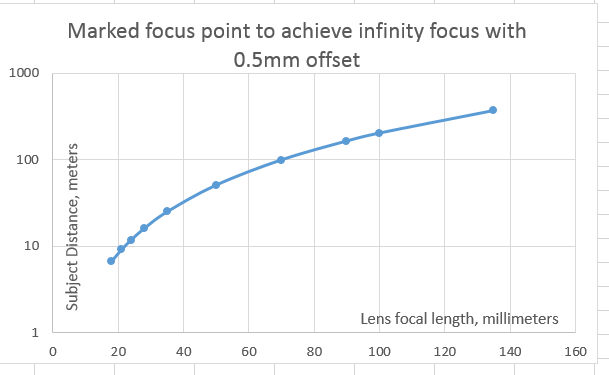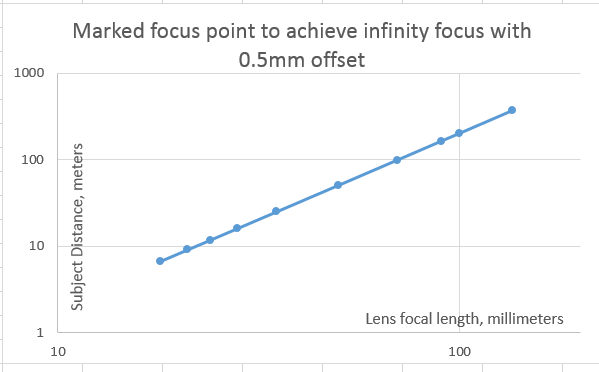The Novoflex Nikon F to Sony E adapter that I used with the Zeiss 21mm f/2.8 is short by about the same amount as the Novoflex Leica M to Sony E adapter that I used with the 24mm f/3.8 Elmar.
I got to wondering why the focusing error caused by improper adapter spacing showed up so much more with wide angle lenses. I made a plot of the focusing error caused by a half-millimeter too short adapter as a function of focal length of the lens:
The vertical axis is logarithmic. It looks like this on a log-log plot:
The same too-short adapter that causes an 18mm lens focused at the 18.5 meter marked distance to actually focus at infinity will cause a 135mm lens focused at the 366 meter marked distance (if you can interpolate to that) to actually focus at infinity. The error is trivial for the long lens, and important for the short one, at least if you pay attention to the marking on the lens.
Judged on the basis of focusing error on short lenses, both my Novoflex adapters are short by about half a millimeter. In the world of machining, this is a big distance. In fact, it’s so large that I don’t see how it could happen by accident. My suspicion is that Novoflex has deliberately made the adapters short. I’m not sure why they’d do that. Maybe they’ve biased their manufacturing process so that if every possible thing adds up in the direction to make the adapter too long, it will turn out to have the right length. That would make the typical adapter short.
I can see why they wouldn’t want an adapter to be too long; the user would never be able to focus to infinity. On the other hand, half a millimeter is a big error, and the fact that I have two adapters that are off indicates that I’m not looking at an outlier.
Do you suppose that they expect that the camera the lens was originally used on could be at one end of its tolerance, and the camera that the lens is being used on with the adapter could be at the other end of the tolerance band, and that they have to apply windage to the adapter to make up for that?
I tried a Metabones adapter, and it’s even shorter than the Novoflex one.


It’s troubling that these expensive adapters run short. Have you checked out the $20 ones?
Only one. It was also too short.
Jim
Allowing the adapter to be short by 0.5mm will allow the legacy lens to focus at infinity before the lens reaches the infinity stop.
This overcomes slight tolerances in lenses and adapters that may expand with heat (or some other environmental influence.
A 0.15mm size increase on an adapter might not allow a legacy lens to focus on distant horizons.
That, IMHO, is a cure worse than the disease. See this for some numbers: http://blog.kasson.com/?p=8843
If heat affects focus materially, it should be taken care of by the lens designer, by allowing the lens to focus beyond infinity. This is commonly done. It doesn’t need to be done twice.
Also, see this: http://www.dpreview.com/forums/post/57309905
Jim
Hi Jim,
It might be a point that focussing at the near end focus throw of lenses is much bigger thus allowing for a more precise (easier) manual focus operation, throughout all distances.
What I mean is that between e.g. 5 and 10m you need to turn the focus ring more than between 10m and infinity, thus allowing to focus precisely more easily.
Regards
Marc
With a normal (linear) helicoid, displacement of the image on the image side of the lens is constant with ring rotation throughout the focusing range. Otherwise, the DOF markings wouldn’t be right at some distances.